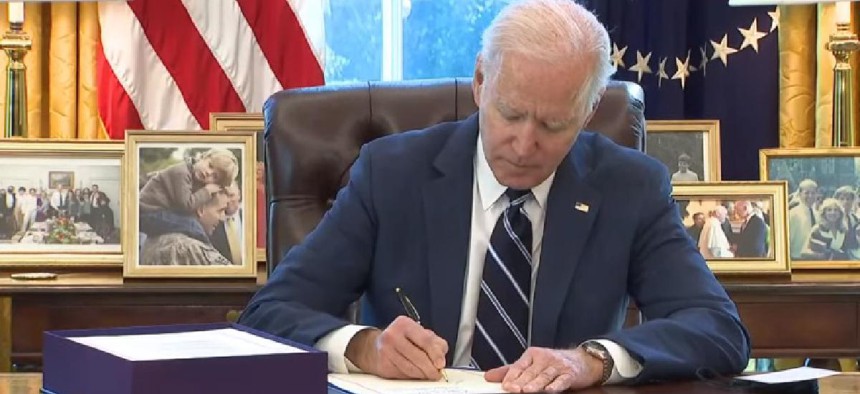Biden signs Rescue bill, boosting TMF and adding pandemic leave for feds

The $1.9 trillion American Rescue Plan Act was signed into law on Thursday. In addition to a massive influx of funding to support Americans harmed by the economic fallout of the pandemic, there is funding available for IT modernization and provision to help the federal workforce cope with COVID-19.

President Joe Biden signed the $1.9 trillion American Rescue Plan on Thursday. The new paid leave for federal employees and the $1 billion investment in the Technology Modernization Fund and other tech provisions are now law.
The House of Representatives and the Biden administration initially urged $9 billion for the TMF, but the price tag was too steep for many on the Senate side. Eventually, lawmakers on the Senate Homeland Security and Government Affairs Committee pressed for the $1 billion addition to the fund, which is currently capitalized at $175 million and is funding 10 projects.
"We need to do more to move away from outdated systems and invest in technology that is cost-effective, secure, and meets the needs of the American people," Sen. Maggie Hassan (D-N.H.) told FCW in an emailed statement. "The $1 billion in funding for the Technology Modernization Fund can be used for government agencies to modernize their legacy IT systems, and I urge agencies to use this funding not just for short-term patches, but as part of broader efforts to modernize outdated systems," she said.
As FCW reported earlier this week, the $1 billion funding boost for TMF could mean some changes in the way the fund operates, including changes to the tempo of required repayments of agencies to the fund.
Matthew Corneilus, former Office of Management and Budget technology adviser and currently executive director of the Alliance for Digital Innovation, suggested Wednesday in an appearance on Government Matters, that it was time for OMB and the General Services Administration to hunt for projects that make sense in the near term.
"It's incumbent on OMB and GSA to stipulate where they want that money to go, rather than sit around and wait for potential agency projects," Corneilus said. Some likely areas of activity for TMF include identity management, collaboration tools and data sharing. He also said that the TMF administrators will likely have to "suspend or update those repayment requirements" in order to push out investments more quickly.
The Rescue Plan also includes $650 million for the Cybersecurity and Infrastructure Security Agency. At a House Appropriations hearing earlier this week, CISA's acting director and the agency's executive assistant director for cybersecurity told lawmakers that the funding will be used to scale cybersecurity pilots designed to increase focus on threat detection at end points and devices and to expand the agency's ability to hunt for threats.
Other tech items include $200 million for the U.S. Digital Service, $150 million for the Federal Citizen Services Fund and $25 million for the Department of Agriculture to improve the technology behind the delivery of the Supplemental Nutrition Assistance Program, to modernize benefits transfer and to push for more mobile access. The bill also contains $7.6 billion to improve internet connectivity at the nation's schools and libraries, via the Federal Communication Commission's E-rate program.
Paid leave for feds
Now federal workers can tap into a new Emergency Paid Leave Fund to get up to 15 weeks of extra time off for pandemic-related reasons, like medically-required self-quarantine, COVID-19 symptoms or vaccination.
Feds can also use the leave to take care of family members who are quarantining or children who are doing virtual or hybrid learning. It can also be used to care for an elderly or disabled family member whose place of care is closed because of COVID-19.
Congress appropriated $570 million for this emergency paid leave, which will be available through Sept. 30, 2021 and capped at $1,400 a week. It also covers feds like postal workers and those working in the D.C. Courts.
The leave won't be available to use concurrently with other types of paid leave.
"This additional leave will give federal employees more time to safely recover from COVID-19 or respond to related family care issues without being forced to take unpaid leave or return to work before it's safe to do so," said Everett Kelley, the national president of the American Federation of Government Employees, in a statement about the passage of the law.
Another provision in the law will make it easier for feds who contract the virus at work to make claims for workers compensation benefits under the Federal Employment Compensation Act.
The bill includes an automatic presumption of illness for feds diagnosed with COVID-19 who work in frontline jobs requiring contact with the public, co-workers or patients. This coverage goes back to January 27, 2020 and is in effect through January 27, 2023.
NEXT STORY: VA watchdog cautions on pandemic hires





